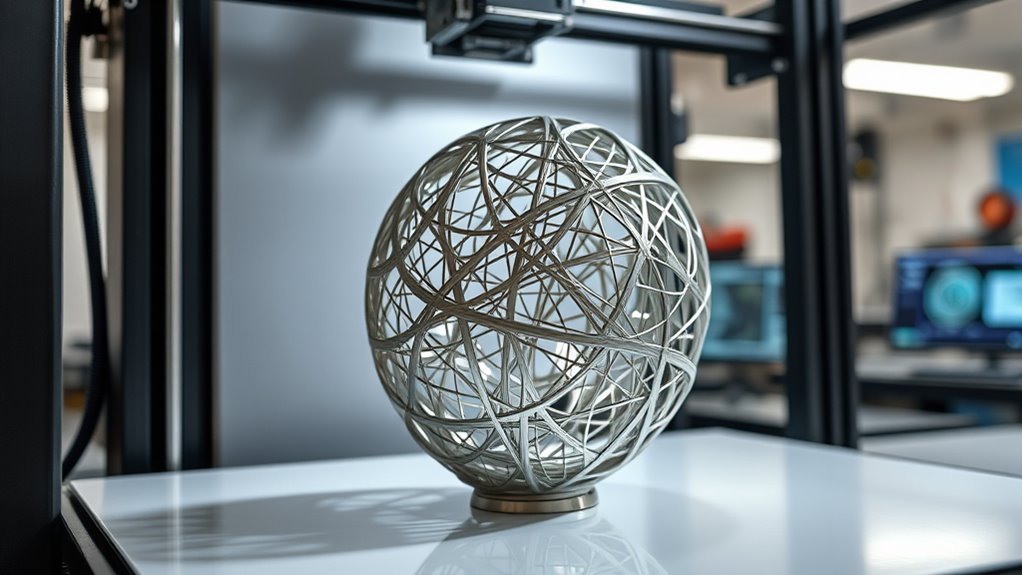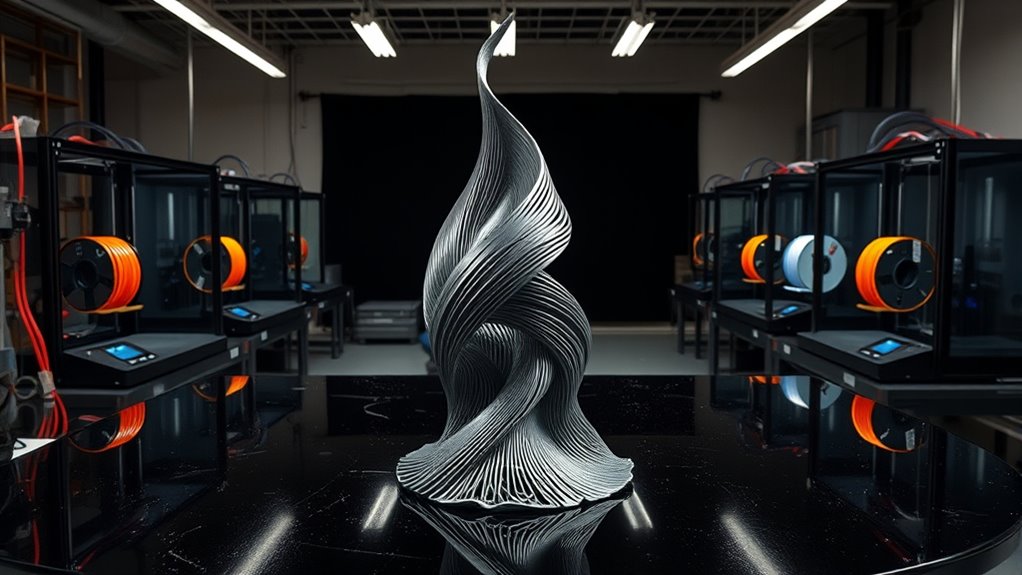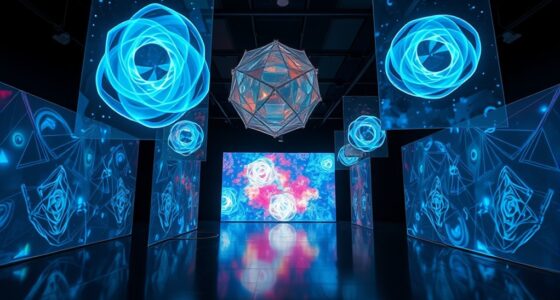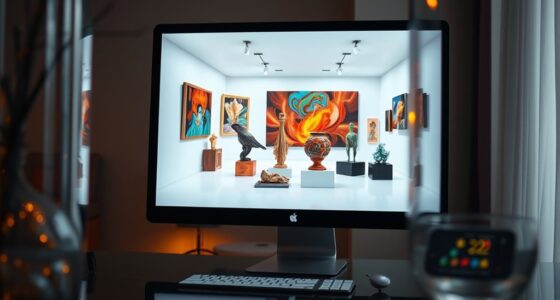3D printing transforms sculpture and design by letting you create complex, detailed, and innovative forms with precision and speed. It offers access to diverse materials like resins, metals, and flexible polymers, enhancing textures and durability. Digital tools enable you to craft intricate patterns and prototypes easily, reducing waste and error. This technology opens endless possibilities for creative experimentation across fields like art, architecture, and jewelry. Keep exploring to discover how these advancements can elevate your projects even further.
Key Takeaways
- Enables creation of complex, detailed sculptures with unprecedented precision and intricate designs.
- Expands material options, including resins, metals, and eco-friendly filaments for diverse artistic needs.
- Utilizes digital tools for accurate modeling, rapid prototyping, and seamless customization.
- Accelerates production, reduces waste, and facilitates iterative refinement of creative projects.
- Opens new avenues in art, architecture, and jewelry by combining innovative materials with advanced manufacturing.

3D printing has revolutionized sculpture and design by enabling artists and designers to create complex, detailed structures with unprecedented ease and precision. This technological leap has opened new frontiers in creative expression, allowing you to push the boundaries of traditional craftsmanship. One of the most significant drivers behind this shift is material innovation. With 3D printing, you’re no longer limited to conventional materials like clay or stone; instead, you have access to a vast array of substances such as resins, metals, bio-based filaments, and even flexible polymers. These advancements mean you can select materials that perfectly suit your project’s aesthetic, structural, or functional needs, creating pieces that were once impossible to produce by hand. This variety enhances your ability to experiment with textures, finishes, and durability, elevating the quality and uniqueness of your work. Material innovation also allows for the integration of sustainable and eco-friendly options, aligning your creative pursuits with environmental consciousness. Digital craftsmanship plays a pivotal role in transforming your approach to sculpture and design. The precision and control offered by digital tools mean you can craft intricate patterns and complex geometries directly from your computer. Instead of laboriously carving or molding, you design digitally, then bring your vision to life via 3D printing. This process minimizes errors, reduces waste, and speeds up production, so you can iterate quickly and refine your ideas with ease. It’s like having a highly skilled assistant that translates your digital models into physical forms flawlessly. With the advent of advanced slicing software and CAD programs, your control over every detail increases exponentially, giving you the ability to create delicate lattice structures, organic shapes, or highly customized pieces with ease. This digital craftsmanship also democratizes sculpture and design, making sophisticated techniques accessible to artists and designers at all levels. Additionally, understanding the reliability of 3D printers and materials can help ensure your projects are successful and durable. Together, material innovation and digital craftsmanship empower you to experiment, innovate, and realize visions that might have once been out of reach. They enable a seamless *progression* from concept to creation, combining the versatility of new materials with the precision of digital tools. As you explore these technologies, you’ll find your creative process becoming more efficient and your work more dynamic. Whether crafting jewelry, architectural models, or avant-garde sculptures, 3D printing allows you to transform ideas into tangible realities with a level of detail and complexity that pushes the limits of traditional craftsmanship. This synergy of innovation and technology is shaping a future where your creative potential is virtually limitless.
Frequently Asked Questions
What Materials Are Most Suitable for 3D Printing Sculptures?
You should consider materials like PLA, ABS, and resin for 3D printing sculptures, as they offer great material versatility and printing durability. PLA is easy to work with and eco-friendly, while ABS provides strength and heat resistance. Resin produces highly detailed and smooth finishes, ideal for intricate designs. Your choice depends on the sculpture’s intended use, detail level, and durability needs, ensuring your project’s success.
How Does 3D Printing Influence Traditional Sculpture Techniques?
You find that 3D printing transforms traditional sculpture techniques by integrating digital fabrication, allowing for precise, complex designs that were hard to achieve manually. It encourages innovative workflows, blending digital and physical artistry. You can experiment rapidly with forms, scale, and details, pushing creative boundaries. This influence makes sculpture more accessible, efficient, and versatile, opening new domains for artists to explore while maintaining the essence of traditional craftsmanship.
What Are the Environmental Impacts of 3D Printed Art?
Imagine a river carving a canyon—3D printed art has a similar impact on the environment. You should consider recyclability concerns, as some materials are hard to repurpose, and energy consumption, which can be high during printing. While it reduces waste compared to traditional methods, you must weigh its carbon footprint and material lifecycle to truly understand its ecological footprint.
Can 3D Printed Sculptures Be Restored or Repaired Easily?
You can restore or repair 3D printed sculptures fairly easily, thanks to material flexibility that allows for precise work and seamless blending. Using compatible filaments or resins, you can fix cracks or breaks, extending repair longevity. Keep in mind, the ease depends on the material used and the extent of damage. With the right techniques, you’ll find maintaining and restoring your sculptures manageable and effective.
How Accessible Is 3D Printing Technology for Emerging Artists?
Imagine stepping into a vibrant studio where you can shape your ideas with ease. While 3D printing has become more accessible, cost barriers and technological literacy can still pose challenges for emerging artists. You might find affordable options, but mastering the technology requires time and effort. With dedication, you can harness this tool to bring your creative visions to life, opening new doors in your artistic journey.
Conclusion
You’ve seen how 3D printing transforms sculpture and design, opening up endless creative possibilities. It’s a game-changer that lets you push boundaries and bring your ideas to life with precision and ease. Don’t overlook its potential — it’s a tool that can make your projects stand out from the crowd. Embrace the technology now, because once you get the hang of it, you’ll realize it’s a whole new ball game, and the sky’s the limit.










